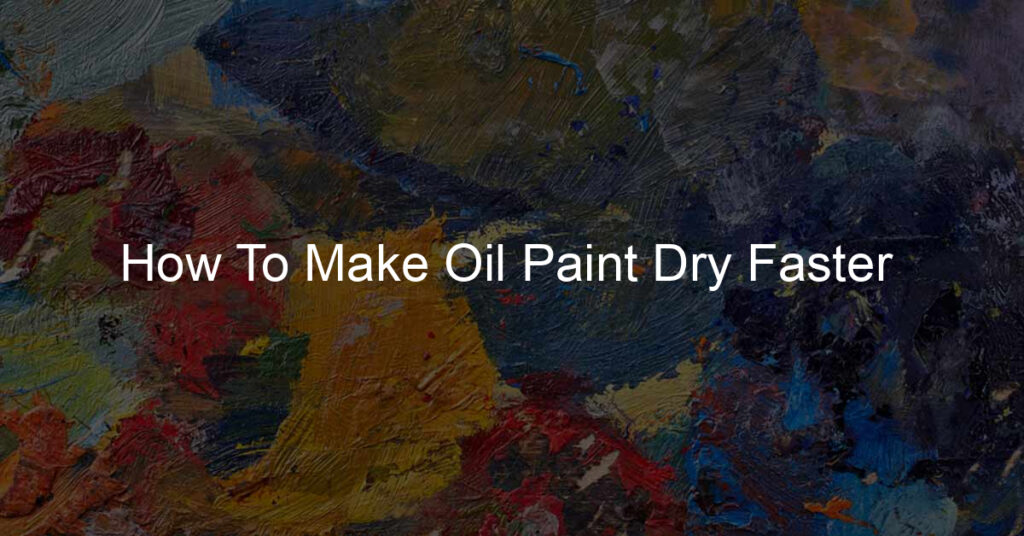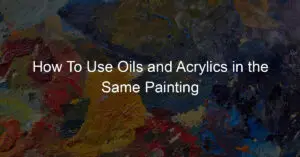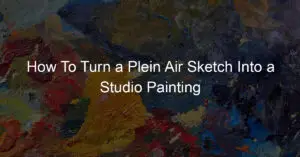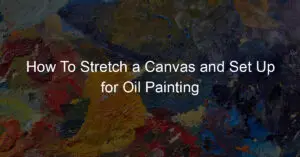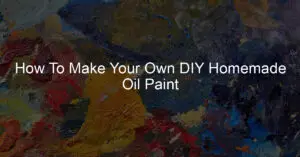Are you wondering how to make oil paint dry faster or how long does it usually take for your oil paintings to dry? Well, depending on the thickness of your layers and the humidity levels in your environment, it could take anywhere from a few days to a couple of weeks.
But what if you need them to dry faster? In this blog post, we will share some tips on how to make oil paint dry faster. Enjoy!
Understanding the Composition of Oil Paint
Oil paint is composed of pigments suspended in a drying oil, typically linseed oil. The oil hardens through a chemical reaction known as oxidation, which occurs when the oil reacts with the oxygen in the air. This is a slow process that can take days, weeks, or even months, depending on the thickness of the paint and the environmental conditions.
In addition, different pigments can affect the drying time of the oil paint. Some pigments, like lead or cobalt, are natural driers and can accelerate the drying process. Understanding the composition of your oil paint can help you better control the drying process.

The Role of Different Mediums in Drying Oil Paint
Mediums play a critical role in the drying time of oil paint. Using a medium can modify the texture and fluidity of the paint and change its drying time. Some mediums, such as linseed oil, speed up the drying time, while others, like poppy seed oil, slow it down.
Linseed oil is often used for underpainting or initial layers in a painting because it dries faster. On the other hand, slower-drying mediums like poppy seed oil are used for upper layers, to prevent cracking caused by faster-drying layers underneath.
Factors That Slow Down Oil Paint Drying Time
Several factors can slow down the drying time of oil paint. The primary ones are the thickness of the paint layer, the temperature, and humidity levels. Thicker layers of paint take longer to dry because the outer layer has to dry before the underlying layer can start drying. Cooler temperatures slow the oxidation process, thereby increasing the drying time. Also, high levels of humidity can slow the drying time of oil paint, as the water molecules in the air can prevent the oil from reacting with the oxygen effectively.
Choosing the Right Oil Paint for Quick Drying
Some brands and types of oil paint are designed to dry more quickly than others. These quick-drying paints usually contain specific driers, such as cobalt, manganese, or lead, which catalyze the oxidation process and make the paint dry faster. When choosing your paint, look for those labeled as quick-drying or read the list of ingredients to check for the presence of these driers. However, keep in mind that these fast-drying paints might behave differently and may require a slightly different technique.
What to Avoid When Trying to Speed Up Oil Paint Drying Time
While there are ways to speed up the drying process, some methods might harm your painting. For example, applying too much heat can lead to cracking or discoloration of the paint. Exposing the painting to sunlight can cause similar problems and also lead to the fading of the pigments. Another mistake is applying a fast-drying layer over a slow-drying one, which can cause the upper layer to crack.
The Impact of Climate and Weather on Drying Time
The climate and weather conditions where you live can greatly affect the drying time of oil paint. As mentioned before, cooler temperatures and high humidity levels slow down the drying process. If you live in a very humid climate, it might be more difficult for you to get your oil paintings to dry quickly. Conversely, if you live in a dry and hot climate, your oil paint might dry too quickly, which can cause it to become brittle and prone to cracking.
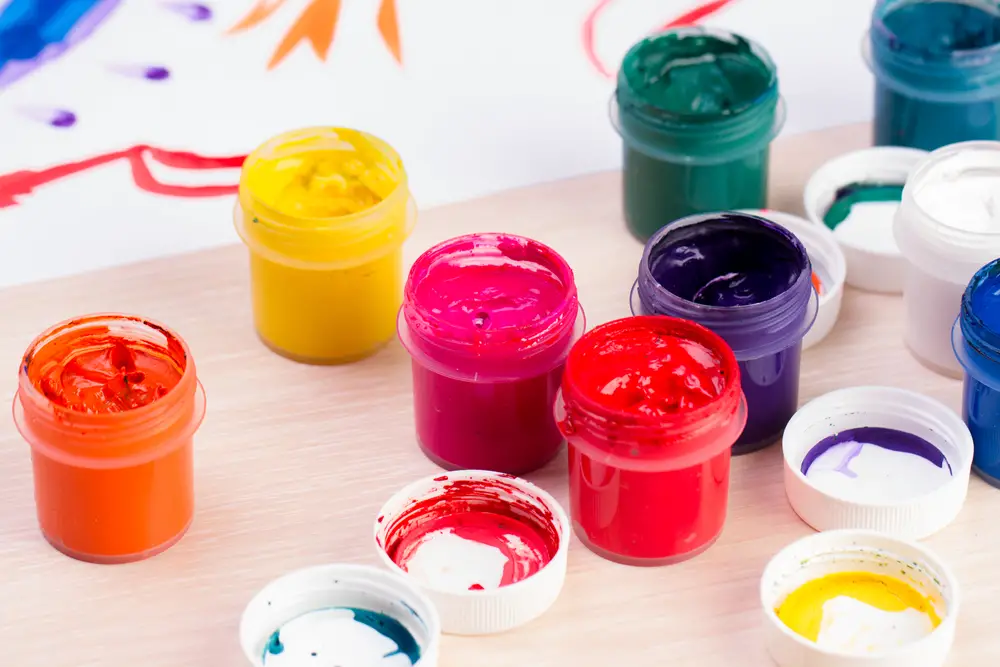
The Effects of Layering on Drying Time
The layering process has a substantial impact on the drying time of oil paints. If a layer of paint is applied over a wet one, it may cause the painting to take significantly longer to dry. Additionally, each layer added to the painting further extends the drying time. Thicker layers also slow down the drying process because the paint’s surface dries first, leaving the inner layer still wet. This is why it’s recommended to follow the “fat over lean” principle in oil painting, which means using thinner, leaner paint (less oil) in the early stages and thicker, fatter paint (more oil) in later stages.
The Pros and Cons of Speeding Up the Oil Paint Drying Process
While speeding up the oil paint drying process can be advantageous, especially when working on a tight schedule, it’s also essential to be aware of the potential drawbacks. On the upside, faster drying times allow artists to apply subsequent layers of paint more quickly, aiding in the overall completion of the artwork. However, the cons can include changes to the texture and appearance of the paint. Speeding up the drying process can lead to a more matte and less vibrant finish. In extreme cases, too rapid drying can cause the paint to crack or flake.
How Quick-drying Techniques Affect the Longevity of Paintings
While quick-drying techniques can be a boon for artists on a tight schedule, it’s essential to consider the potential impact on the longevity of the painting. If the paint is forced to dry too quickly, it may not adhere to the surface as well, leading to potential chipping or flaking over time. Additionally, applying heat or using additives to speed up drying can lead to discoloration or a less vibrant finish, which can affect the artwork’s visual appeal over time. Therefore, while these methods can be useful in certain circumstances, they should be used judiciously and with an understanding of the potential long-term effects.
Tips and Tricks for Managing Oil Paint in a Professional Art Studio
Managing oil paint effectively in a professional art studio can be a delicate balancing act. Understanding how to manipulate drying times can greatly impact the overall workflow. Use quick-drying mediums for underpainting and layers that need to be overpainted quickly. Invest in a quality drying cabinet or rack, ensuring that paintings are stored safely and optimally for drying. Keep your studio well-ventilated and at a constant, moderate temperature. Remember, sometimes patience is key. Rushing an oil painting’s drying process can compromise the final result.
Real-life Examples of Faster Drying Techniques from Famous Artists
Many renowned artists have developed their methods for speeding up the drying time of oil paints. For example, Vincent Van Gogh was known to use copious amounts of lead white, which is a fast-drying pigment, in his paintings. He would also sometimes paint outdoors, letting the wind and sun dry his paintings more quickly. In modern times, artists might use mediums like Liquin, an alkyd resin that can significantly speed up the drying time of oil paints. Each artist will find their rhythm and methods for managing the drying time of their oil paints, often through trial and error.
How Soon Can Oil Paint Dry?

Oil paint is a popular medium for artists, but it can take days or even weeks for a painting to fully dry. If you’re in a hurry, there are a few things you can do to speed up the drying process.
So how long does it take oil paint to dry? This is a question that frequent painters ask since the drying time of oil paint can vary depending on the materials used and the environment.
Generally, it takes between 6 to 24 hours for a thin layer of oil paint to dry completely and 2 to 3 days for a thicker layer. However, there are ways to speed up the drying process. For example, using a hair dryer or paint in direct sunlight will help to accelerate the drying time.
Additionally, some oil paints contain driers that help to shorten the amount of time needed for the paint to set. If you are hoping to speed up the drying process, there are a few things you can do to help your paint dry faster. But first, it is important to understand how oil paint dries to know how best to make it work for you.
Oil paint dries through an oxidation process that is dependent on several factors, including temperature, humidity, and air circulation. In general, warmer temperatures will cause the paint to dry faster while cooler temperatures will slow down the drying process. Additionally, having good circulation in the room where you are painting will also help the paint to dry more quickly.
However, too much airflow can dry and may cause problems with your painting surface. Humidity can also affect how fast your oil paints dry. Low humidity will cause the paint to dry more slowly while high humidity can lead to problems with your painting surface or with subsequent layers of paint adhering properly.
For this reason, it is often recommended that artists thin their oil paints slightly when painting in high humidity conditions. All of these factors – temperature, air circulation, and humidity – play a role in how long it takes oil paints to dry completely.
While there is no definitive answer to the question “how long does it take oil paint to dry?” understanding how different materials and environmental conditions impact the drying process will help you be better prepared when starting your next project.
By taking into account these various factors, you can tailor your approach so that your oil paints will dry in the timeframe that works best for you and your project.
One way to make oil paints dry faster is to use a thinner paint layer. This will allow the paint to dry from the surface down, rather than from the bottom up. You can also add a drying medium to your paint to speed up the oxidation process. Some common options include linseed oil, safflower oil, and walnut oil.
Another way to make oil paint dry faster is to increase the temperature and humidity of your painting environment. This can be done by using a hair dryer or heat gun, or by simply placing your painting in a warm room.
Finally, be sure to avoid direct sunlight, as this can cause the paint to discolor or fade. By following these tips, you can make oil paints dry faster so that you can move on to your next project.
How To Make Oil Paint Dry Faster In 10 Steps?
Is your oil paint taking forever to dry? Here are 10 tried and true methods to speed up the drying time of your oil paint so you can move on to the next steps in your project sooner.
1. Use fast-drying oil paint: Certain brands of oil paint boast a quicker drying time than others. If you’re in a hurry, do some research and purchase one of these types of paints the next time you’re at the art store.
2. Add a dryer: A dryer is an additive that you can mix into your paint which will help it to dry more quickly. This is a great option if you’re not ready to invest in a new type of paint just yet.
3. Use a heat gun: Applying gentle heat to your painting will help to speed up the drying process. Just be careful not to overdo it or you could damage your painting.
4. Thin your paint: Thin layers of oil paint will dry more quickly than thick layers. So, if you’re in a hurry, consider thinning your paint slightly before beginning to work.
5. Painted surface: If you’re working on a smooth, non-porous surface, your paint will dry more quickly than if you’re working on a rougher, more absorbent surface such as canvas or wood. Choose wisely!
6. Direct sunlight or other sources of intense heat: This one’s a bit of a double-edged sword; while exposing your painting to direct sunlight or another source of intense heat will help it to dry more quickly, it can also cause cracks and other damage to occur, so use this method with caution.
7 . Warm environment: Simply moving your painting into a warmer room can help to speed up the drying process – just don’t put it too close to any heat sources like radiators or fireplaces which could damage it.
8. Ventilation: Good airflow will help the fumes from your oil paint to dissipate more quickly, speeding up the overall drying time. Open some windows or set up a fan before beginning to work.
9 . Natural light: Like with direct sunlight, exposure to too can help your painting to dry more quickly but beware of potential damage.
10. Oil-based paint: This type of paint dries more quickly than water-based options, so keep this in mind when making future purchases.
By following these tips, you should be able to get your oil paints to dry much faster than usual! Have any other suggestions? Share them in the comments below!
Conclusion
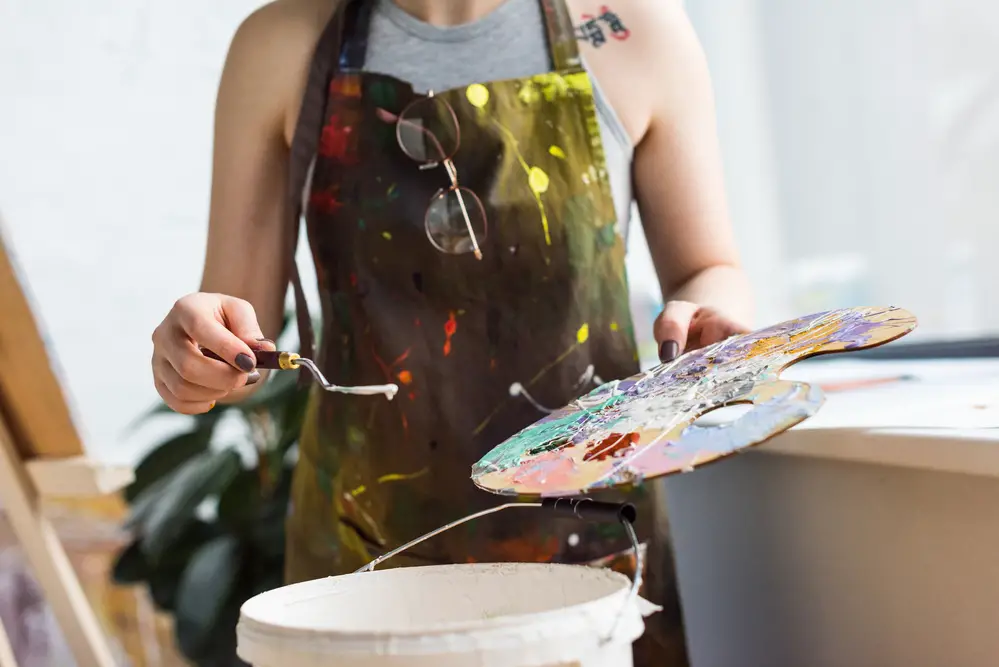
If you make use of oil paint then you will have the topic of this post bugging your mind. This is a question that’s often asked by beginners and experienced painters alike. While the drying time of oil paint can vary depending on the brand, type of paint, and other factors, there are ways to speed up the process.

